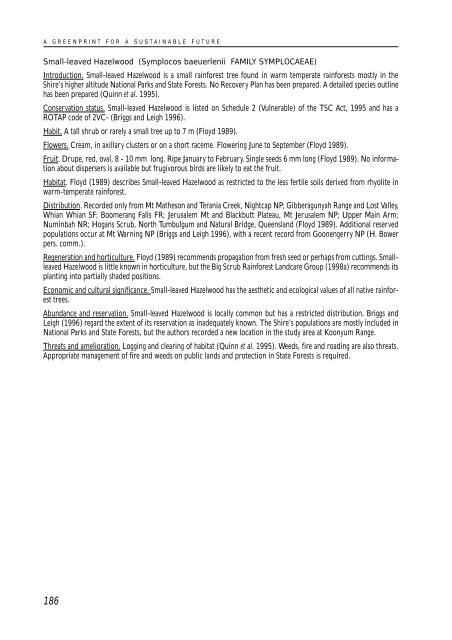Byron Flora and Fauna Study 1999 - Byron Shire Council
Byron Flora and Fauna Study 1999 - Byron Shire Council
Byron Flora and Fauna Study 1999 - Byron Shire Council
Create successful ePaper yourself
Turn your PDF publications into a flip-book with our unique Google optimized e-Paper software.
A GREENPRINT FOR A SUSTAINABLE FUTURE<br />
Small-leaved Hazelwood (Symplocos baeuerlenii FAMILY SYMPLOCAEAE)<br />
Introduction. Small-leaved Hazelwood is a small rainforest tree found in warm temperate rainforests mostly in the<br />
<strong>Shire</strong>’s higher altitude National Parks <strong>and</strong> State Forests. No Recovery Plan has been prepared. A detailed species outline<br />
has been prepared (Quinn et al. 1995).<br />
Conservation status. Small-leaved Hazelwood is listed on Schedule 2 (Vulnerable) of the TSC Act, 1995 <strong>and</strong> has a<br />
ROTAP code of 2VC- (Briggs <strong>and</strong> Leigh 1996).<br />
Habit. A tall shrub or rarely a small tree up to 7 m (Floyd 1989).<br />
Flowers. Cream, in axillary clusters or on a short raceme. Flowering June to September (Floyd 1989).<br />
Fruit. Drupe, red, oval, 8 - 10 mm long. Ripe January to February. Single seeds 6 mm long (Floyd 1989). No information<br />
about dispersers is available but frugivorous birds are likely to eat the fruit.<br />
Habitat. Floyd (1989) describes Small-leaved Hazelwood as restricted to the less fertile soils derived from rhyolite in<br />
warm-temperate rainforest.<br />
Distribution. Recorded only from Mt Matheson <strong>and</strong> Terania Creek, Nightcap NP; Gibberagunyah Range <strong>and</strong> Lost Valley,<br />
Whian Whian SF; Boomerang Falls FR; Jerusalem Mt <strong>and</strong> Blackbutt Plateau, Mt Jerusalem NP; Upper Main Arm;<br />
Numinbah NR; Hogans Scrub, North Tumbulgum <strong>and</strong> Natural Bridge, Queensl<strong>and</strong> (Floyd 1989). Additional reserved<br />
populations occur at Mt Warning NP (Briggs <strong>and</strong> Leigh 1996), with a recent record from Goonengerry NP (H. Bower<br />
pers. comm.).<br />
Regeneration <strong>and</strong> horticulture. Floyd (1989) recommends propagation from fresh seed or perhaps from cuttings. Smallleaved<br />
Hazelwood is little known in horticulture, but the Big Scrub Rainforest L<strong>and</strong>care Group (1998a) recommends its<br />
planting into partially shaded positions.<br />
Economic <strong>and</strong> cultural significance. Small-leaved Hazelwood has the aesthetic <strong>and</strong> ecological values of all native rainforest<br />
trees.<br />
Abundance <strong>and</strong> reservation. Small-leaved Hazelwood is locally common but has a restricted distribution. Briggs <strong>and</strong><br />
Leigh (1996) regard the extent of its reservation as inadequately known. The <strong>Shire</strong>’s populations are mostly included in<br />
National Parks <strong>and</strong> State Forests, but the authors recorded a new location in the study area at Koonyum Range.<br />
Threats <strong>and</strong> amelioration. Logging <strong>and</strong> clearing of habitat (Quinn et al. 1995). Weeds, fire <strong>and</strong> roading are also threats.<br />
Appropriate management of fire <strong>and</strong> weeds on public l<strong>and</strong>s <strong>and</strong> protection in State Forests is required.<br />
186

















